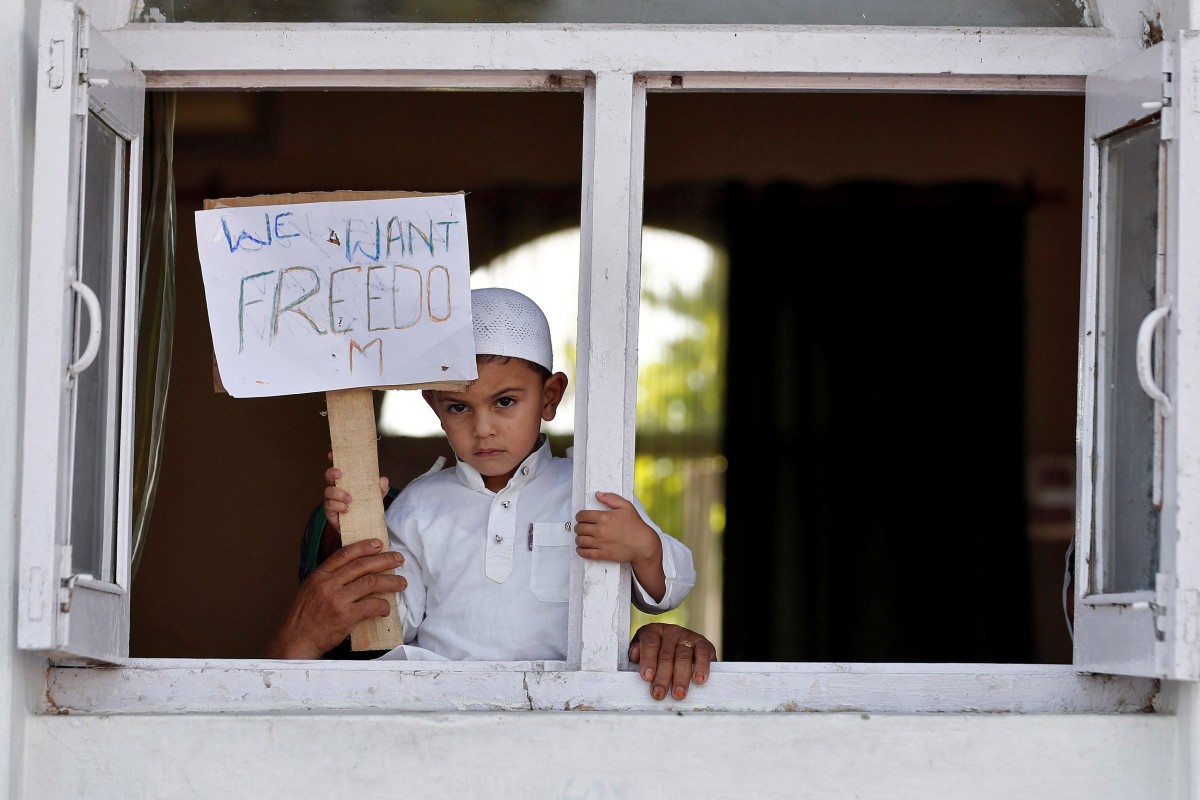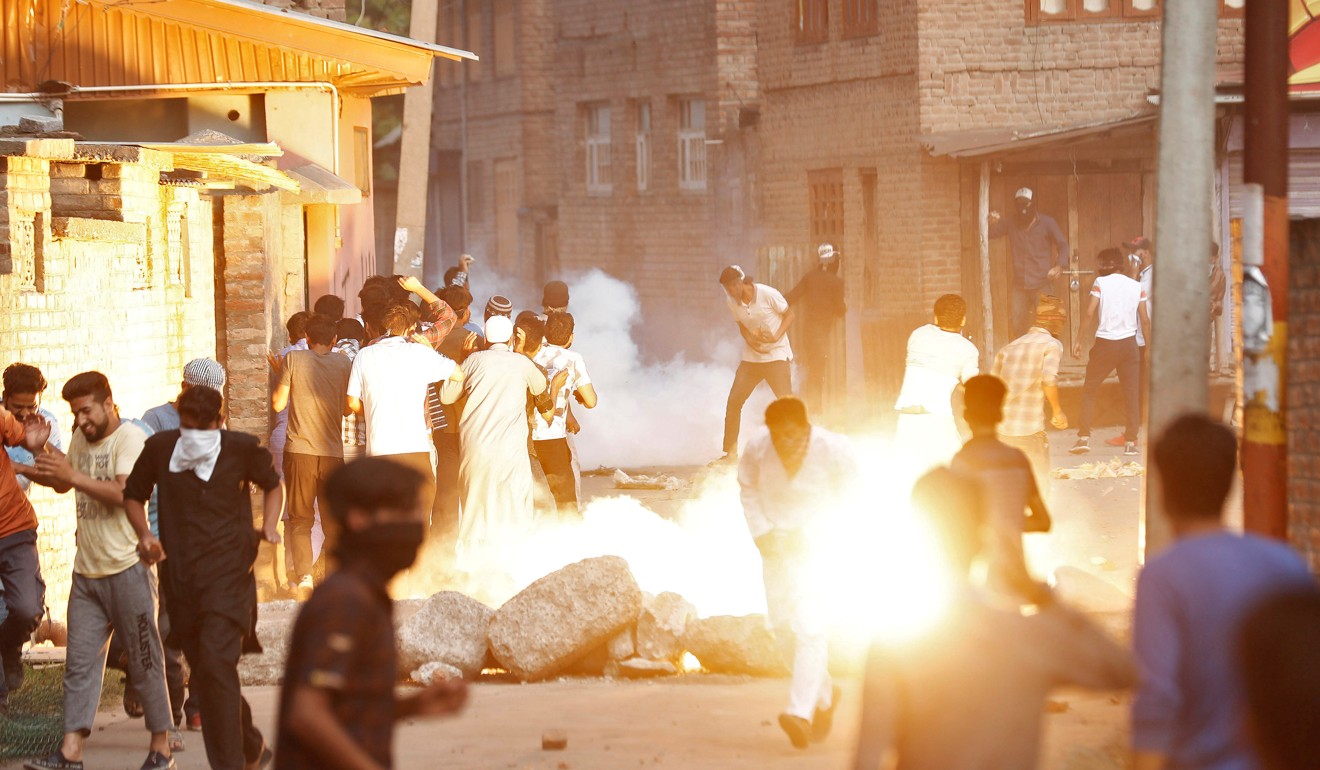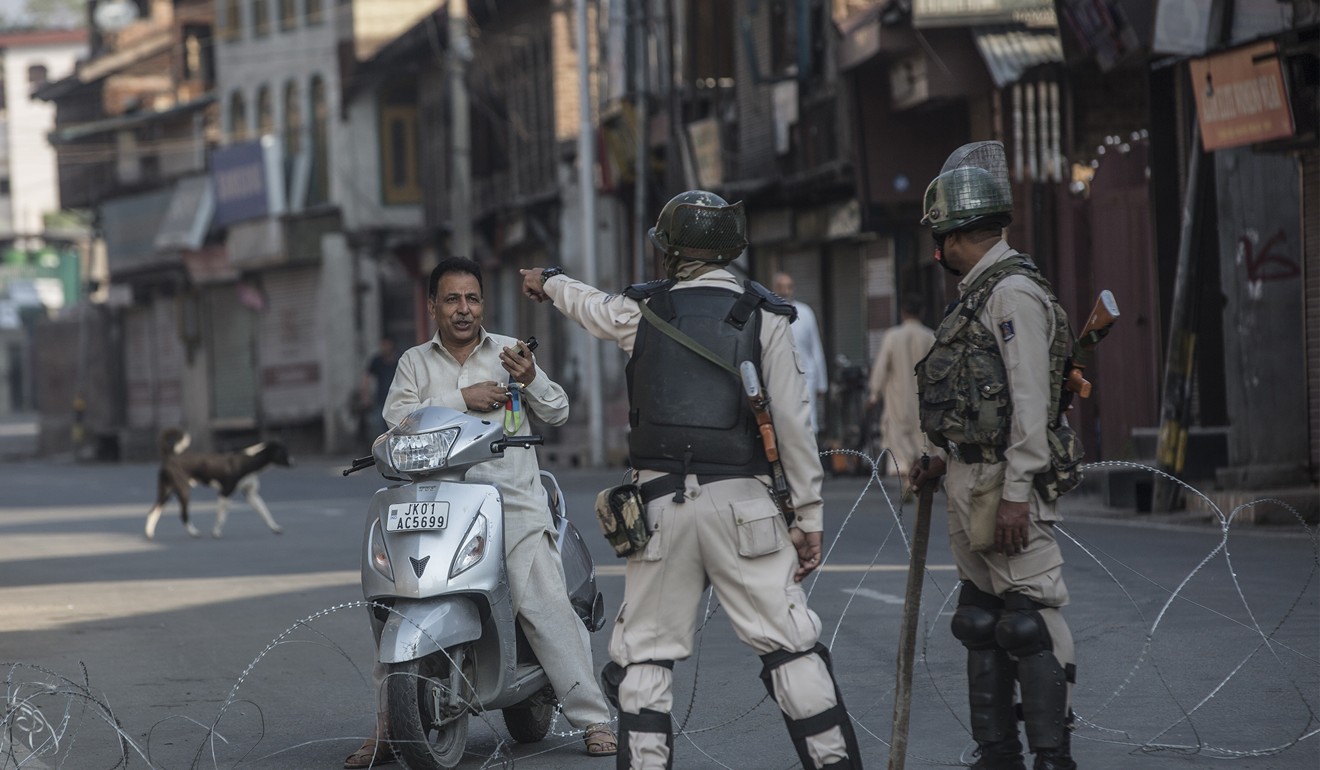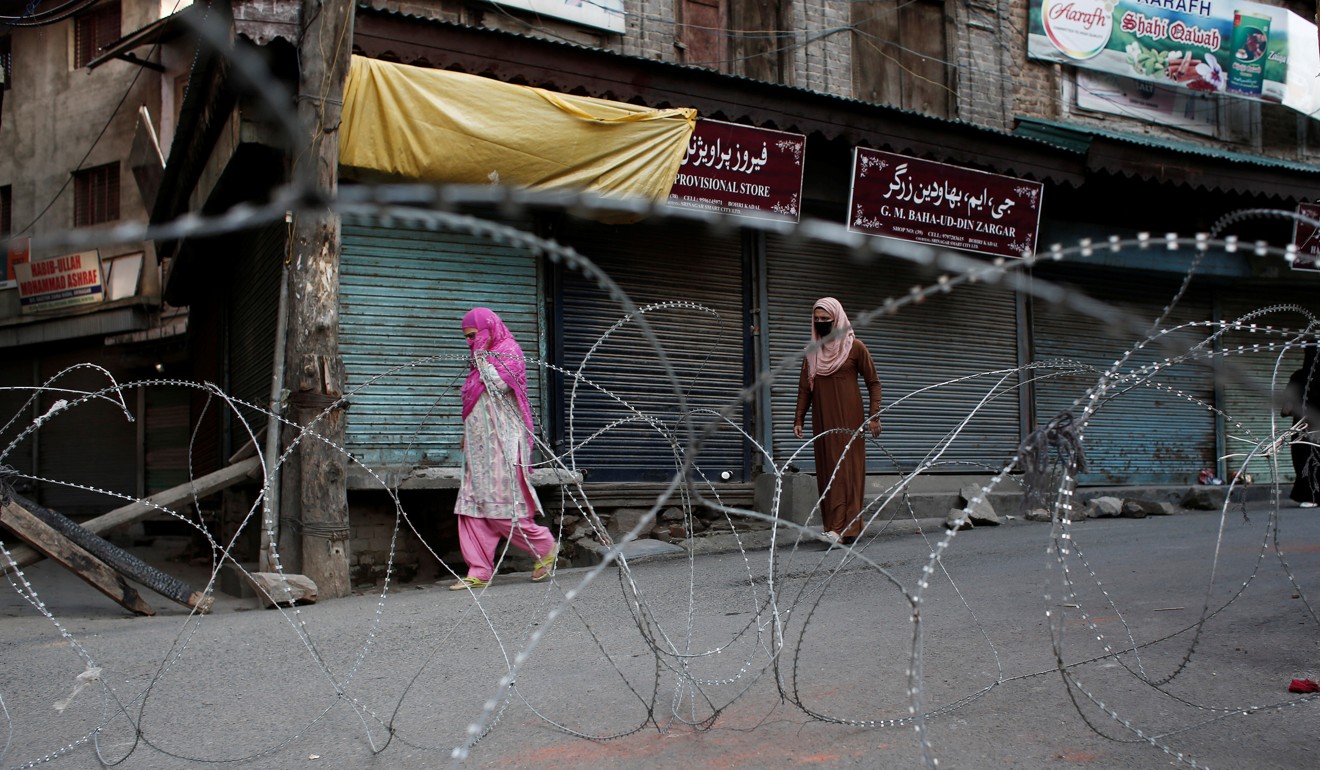- Constant monitoring has whipped residents into near paranoia, as drones fly over Friday prayers in mosques and police inspect cameras
- The revocation of Kashmir’s special status has led to increased surveillance, long a mainstay of New Delhi’s approach to managing the restive state
Ahmer Khan and Adnan Bhat

A Kashmiri boy displays a placard from a window at a protest site after Friday prayers. Photo: ReutersOn August 23, as the residents of Anchar in Srinagar, in Indian-administered Kashmir, were preparing for Friday prayers at the local mosque, multiple police surveillance drones hovered above them.
After the prayers concluded, children unsuccessfully attempted to bring down the drones by hurling stones high into the air. Young boys hid their faces and avoided looking up, fearing pictures taken by the drones could be later used against them by local police.Later, men and women of all ages holding placards urging the United Nations and Western powers to take up the Kashmir issue gathered in the compound of the mosque for another protest. As they began their march, the drones above them followed.
Hong Kong is in India, Kashmir is in China. Right?
Waving flags, the protesters shouted anti-India and pro-freedom slogans. They moved through small alleys on the periphery of Anchar Lake. The drones above kept on their tail. Soon the protesters were intercepted by a party of Indian paramilitary forces, who fired tear gas and pellet guns into the crowd to disperse them. The young men in the protest retaliated with stones.
The confrontation lasted more than two hours. When the dust settled, two young men had suffered pellet injuries, while another young boy had been hit in the shin by a tear gas shell.

Kashmiris run for cover as a tear gas shell fired by Indian security forces explodes on August 23. Photo: ReutersShare:SUBSCRIBE TO THIS WEEK IN ASIAGet updates direct to your inboxSUBMITBy registering, you agree to our T&C and Privacy PolicyADVERTISING
Nazir Ahmad, a resident, said police had been using multiple drones to monitor the area at all hours. Although Indian paramilitary troops have been unable to gain access to the neighbourhood, they guard all entries to the area. According to locals, this is to prevent protesters from marching on the main road where more people could join them.
“Drones are here now every day. They are tracking every movement in this area,” Nazir said. “They are operated from the nearby police station. On Eid, we had five helicopters in the area for aerial surveillance. We heard Ajit Doval was in one,” he added, referring to India’s national security adviser, tasked by the government to contain the seething anger in Kashmir.
Two weeks earlier, a massive protest rally from the area escalated into clashes between Indian paramilitary forces and protesters, during which several people were wounded by pellets. When reports of the clashes appeared in international media, the Indian government vehemently denied the incident ever took place.
Deft diplomacy and economic realism help India sell its Kashmir and Assam policies
On August 5, the Indian government unilaterally scrapped Article 370 of the Indian constitution, which had guaranteed the special status and autonomy of Jammu & Kashmir and reserved the right to own land in the state for its permanent residents.
To mitigate any protests by people in Kashmir, New Delhi imposed a strict lockdown on the region. More than three weeks later, phone and internet lines in the Kashmir Valley remain cut off, although government officials have insisted some landline phone connections have been restored.
Heavily armed forces continue to patrol the streets, and Kashmiri political leaders remain in detention. Thousands of other civilians have also been detained after night-time raids to quell any possible opposition. Some of them have been sent to different jails across India, thousands of kilometres away. The Indian government has not revealed how many have been detained.

Indian paramilitary troopers ask a Kashmiri man to leave in Srinagar city, the summer capital of Indian-controlled Kashmir. Photo: XinhuaShare:
Since the military lockdown began in Kashmir, surveillance of civilians has increased. In fact, for years it has been a mainstay of the Indian government’s strategy to manage the situation. A few months ago, retired Indian army general Syed Ata Hasnain advocated for increased mass surveillance in the state.
In a column for an Indian website, Syed wrote: “ … while physical domination is as much necessary, the priority should be intelligence, not the variety which fetches terrorist kills, but the one which focuses on emerging personalities and preventing them from becoming larger than life.”
The general has also called for the close monitoring of social media in Kashmir.
Drones are here now every day. They are tracking every movement in this areaAnchar resident Nazir Ahmad
In South Kashmir, home to a new generation of militants fighting against Indian rule, drones have been in operation for years to track militants and their sympathisers.
They are now a common sight across the entire state. Every once in a while, the sound of choppers flying low to the ground can be heard.
Srinagar’s skyline is dotted with police-operated CCTV cameras mounted on mobile phone towers.
Paramilitary forces across the region have set up checkpoints and laid out barbed wire, allowing them to monitor the movement of residents and record the registration numbers of some civilian vehicles. Sometimes, people are even quizzed about their destination and where they came from.
Pakistanis in Hong Kong condemn Modi’s move to strip Indian-held Kashmir of autonomy
Omair Rasool, a college student, has witnessed the increase in mass surveillance. A resident of downtown Srinagar, an old neighbourhood which has for years been a centre of anti-India protests, he said there had been a gradual increase in state monitoring.
“There would be protests every Friday here in downtown. But there are hardly any protests in the area over the last three weeks,” he said, explaining that most of the youth from the area who would take part in such demonstrations had been already detained by police in anticipation.
Others who dared test the authorities’ iron grip have been taken away in the night raids.

Kashmiri women walk past concertina wire laid across a road during restrictions after the scrapping of the state’s special constitutional status. Photo: ReutersShare:
“There were a few small protests in the area but the police detained all of them. They had a list of names with them and even photographs,” Rasool said.
It’s not just civilians who are bearing the brunt of increased state surveillance – many journalists working in the region allege Indian forces have forced them to delete footage.
Imran Ali, a video journalist in Kashmir, was briefly detained on Eid morning. He said police checked his camera for any videos or photos the state did not want released to the outside world, determined to preserve the facade of normalcy.
[Police] stopped me and when I told them I’m a journalist, it infuriated them Imran Ali
“They stopped me and when I told them I’m a journalist, it infuriated them,” he said. “They asked to see my camera. I was worried they may even break it. But thankfully, I had the footage and photos of the protests in a different memory card.”
Many of the injured avoid hospitals, even if it means spending days in pain with iron pellets lodged in their bodies. They say policemen in civvies have been stationed in hospitals to record the names of people brought in with such injuries – and later raid their houses.
“They use hospital records to prove you had been in the protests. That way they can simply justify the arrest,” said a boy who was injured in a protest on August 30.
Bollywood teaches more about Kashmir than India’s schools
Before the lockdown, the government asked doctors to keep emergency wards as vacant as possible in anticipation of clashes between protesters and Indian forces. Dr Burhan, who works in the emergency ward of the Sher-i-Kashmir Institute of Medical Sciences, one of the biggest hospitals in the state, treated some of the injured in the Soura area outside the hospital to help them avoid state surveillance.
Whenever someone is injured, the locals send someone to the hospital to get Burhan. Sometimes they even visit his home when he is off duty.
“As a doctor, my first responsibility is toward the patient,” he said. “So I’m trying to do my best even if it may get me in trouble.”This article appeared in the South China Morning Post print edition as: in indian military lockdown, every movement is tracked India
